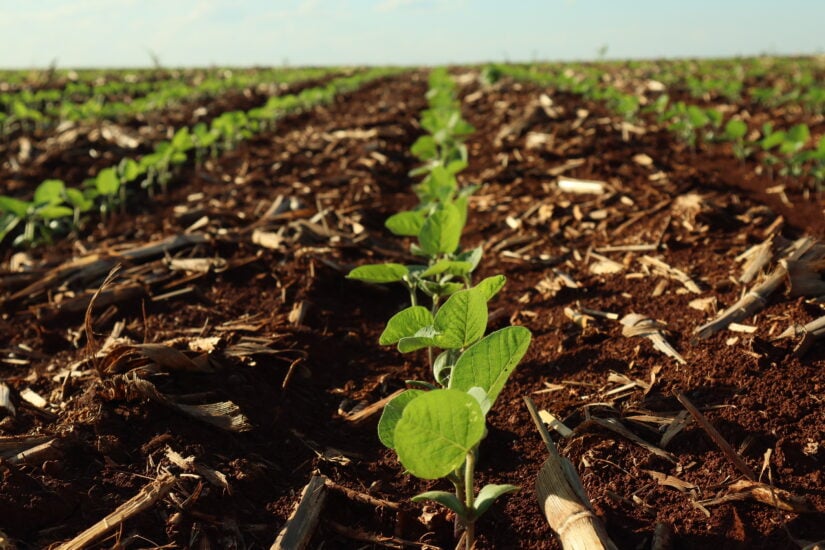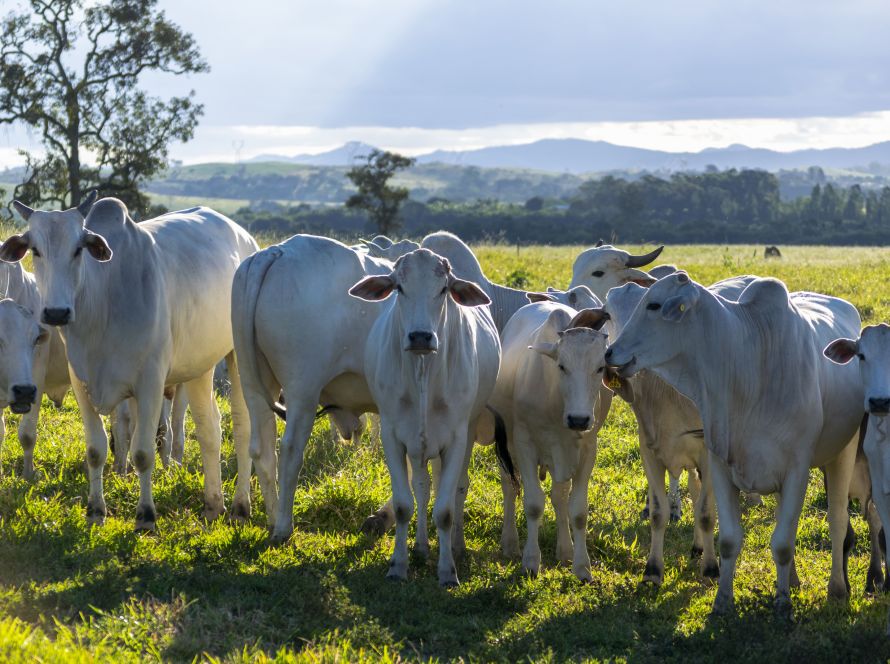According to data from the SIGA-MS Project, executed by Aprosoja/MS, the soybean area in the 2024/2025 harvest in Mato Grosso do Sul reached 4.524 million hectares, with a weighted average productivity of 51.78 bags per hectare, and production of 14.060 million tons.
The weighted productivity averages by region were as follows: 72.01 sc/ha in the northern region, which represents approximately 15.8% of the area monitored by the Project; 52.63 sc/ha in the central region, which corresponds to approximately 22.6% of the monitored area; and 46.29 sc/ha in the southern region, which covers approximately 61.6% of the cultivation area monitored by the project.
“The analysis of soybean productivity in the 2024/2025 harvest reveals important insights into the agricultural performance of municipalities in Mato Grosso do Sul. The average state productivity was 51.79 bags per hectare (sc/ha), the result of a weighted average that considers both individual productivity and the planted area of each municipality. Some municipalities stood out with productivity significantly above average, contributing significantly to the overall performance”, points out the technical coordinator of Aprosoja/MS, Gabriel Balta.
Among these municipalities that stood out are: Costa Rica (78.36 sc/ha in 89,584 ha); Chapadão do Sul (77.03 sc/ha in 131,336 ha); São Gabriel do Oeste (74.78 sc/ha in 129,606 ha); Maracaju (72.06 sc/ha in 353,130 ha), and Paraíso das Águas (70.72 sc/ha in 100,003 ha).
“These municipalities, located mainly in the north and northeast regions of the state, combine high productivity with large cultivated areas, exerting a strong positive influence on the state average. On the other hand, municipalities with large planted areas, but lower-than-average productivity, negatively impact the state result.”
The following municipalities presented productivity below the state average: Dourados (39.9 sc/ha in 249,420 ha); Sidrolândia (49.1 sc/ha in 276,829 ha); Ponta Porã (49.7 sc/ha in 348,125 ha) and Rio Brilhante (50.9 sc/ha in 171,269 ha).
These municipalities have lower than expected productivity, which reduces the state weighted average. According to data from the SIGA-MS Project, the advancement of irrigation has been an important differentiator. Municipalities such as Ribas do Rio Pardo, Três Lagoas, Selvíria, Água Clara and Paranaíba, where most soybeans are grown under irrigation, have high productivity, demonstrating the potential of this technology to increase production rates.
This scenario highlights the importance of implementing specific technical actions and public policies aimed at increasing productivity in the main agricultural hubs that operate below their potential. In this context, identifying the 30 municipalities with above-average productivity and the 48 that remained below it becomes essential to guide the sector's strategic planning.
“The mapping compiled by Aprosoja/MS allows for more precise targeting of investments, public policies and technical interventions, promoting both the strengthening of the most efficient regions and the recovery of those whose performance is below expectations.”
Survey numbers
The productivity survey was carried out between January 2 and May 16, 2025, completing 19 weeks of monitoring, which allowed obtaining a sample of 1,616 properties, in 1.8 million hectares, considering the different levels of productivity related to the planting season. To determine the cultivated area, the technical team of Aprosoja/MS carried out the georeferencing of the crops in the field, covering extensive areas. In this harvest, 29,074 kilometers were covered and 31,348 GPS points were collected.
“After this survey, the information was corroborated with satellite images to complete the sensing work. This process resulted in the determination of the planted area at the state level. This data collection method, which combines field work with remote sensing technology, allows for an accurate and reliable assessment of the soybean area,” says Gabriel.
Data collection
Throughout the 2024/2025 soybean harvest, between the months of September and May, the Aprosoja/MS field team collected samples in the field and conducted interviews with producers, Rural Unions and Technical Assistance companies.
For data collection, properties in the main producing municipalities of the state were visited and information was collected such as varieties planted, sowing date, cultivated area, grain storage units, incidence of weeds, pests, diseases, precipitation and general condition of the crops. To monitor pre-planting, planting, development and harvesting, 2,471 visits were made (Figure 01). It is worth mentioning that some of these properties were visited more than once during the harvest.
Sampling
The SIGA-MS project productivity methodology is based on field data collection, in which technicians evaluate all technical parameters on a sample basis. The average number of plants per row, average number of grains per plant, losses and weight of a thousand grains are evaluated and adjustments are made based on grain moisture, which directly influences productivity per hectare.
In a definitive manner, the productivity reported by the producer on the total area is always taken into consideration. Since the sample assessment does not allow for the entire property to be extended, this data is valuable and considered for this survey, which provides certainty about what is produced on grain-producing properties in the state of Mato Grosso do Sul.
Subsequently, the productivity data is weighted, taking into account the planted area of each property. Each property and its area represent a percentage of the municipality's productivity. In addition, the planted area of each municipality contributes to the total productivity of the state of Mato Grosso do Sul. This process ensures that properties and municipalities with larger areas have a proportionally greater impact on the final average productivity of the municipality and the state.
In addition, a detailed mapping of the land cover in the state of Mato Grosso do Sul is carried out to identify the extent of the main crops. The survey includes the recording of geographic coordinates and is conducted by a technical team that covers extensive areas, generating thousands of kilometers and GPS points. After this survey is carried out, it is corroborated with satellite images to finalize the remote sensing work, resulting in the determination of the area planted in the state.
History of the first harvest 2024/2025
The 2024/2025 soybean harvest in the state of Mato Grosso do Sul began with positive expectations of growth in the planted area, with an expansion of 6.8% compared to the previous cycle, totaling 4.5 million hectares. Initial estimates, based on the average of the last five years of the SIGA-MS project, pointed to a productivity of 51.7 bags per hectare, which would result in an estimated production of 13.9 million tons.
Climate
During the month of September, much of the state recorded rainfall below the historical average, with volumes between 0 and 30 mm, especially in the Pantaneira, Norte and Bolsão regions. On the other hand, the Sul, Leste and Sudeste regions had volumes between 45 and 90 mm, exceeding the historical average. Planting began with a concentration of 3.3%, above the average of the last five years.
In October, rainfall remained below average in much of the state, with volumes between 30 and 60 mm in the Pantaneira, Leste and Bolsão regions. In the Central, Norte and Sul regions, volumes varied between 90 and 180 mm, remaining above average. In that month, 55% of the total area was planted.
The month of November also presented rainfall below the historical average in regions such as the Center-South, Southwest and Pantanal (40 to 120 mm). On the other hand, the North, East and Northeast regions recorded volumes between 120 and 240 mm. Planting reached 97.4% of the total area.
In December, rainfall exceeded the historical average in regions such as the Southeast, East, North and Northeast (150 to 300 mm), while in the Central, South and Southwest regions the volumes were between 50 and 100 mm, below average. Planting was completed in the second week of the month, which also marked the beginning of a dry period.
January 2025 was characterized by drought, with below-average rainfall (0 to 120 mm) in the Center-South, East and Southeast regions. The Northwest, North and Northeast regions recorded volumes between 120 and 200 mm. The harvest began, with 3.1% of the area harvested. The drought mainly affected the municipalities of the South and Central regions, impacting grain filling, a phase in which 57% of crops were in until January 31.
In February, the drought persisted in much of the state, with rainfall between 30 and 120 mm in the Southwest, Pantanal, South and Southeast regions. The Central and North regions recorded volumes between 120 and 180 mm. The harvest advanced to 50.5% of the estimated area. The first productivity review, based on 10.7% of the sampled area, indicated an average of 54.4 bags per hectare — an increase of 11.4% compared to the previous cycle, raising the production expectation to 14.686 million tons (+18.9%). Compared to the initial estimate, there was an increase of 5% in productivity.
March saw below-average rainfall (30 to 90 mm) in the Southeast, East and Northeast regions, and above-average rainfall (90 to 180 mm) in the Center-North and Southwest regions. The harvest reached 93% of the area, with the drought still present, but without significant additional impact on production.
April was marked by above-average rainfall (150 to 300 mm), especially in the Central, South, East and North regions. The positive precipitation anomaly made the harvesting process difficult, which reached 99.7%, keeping some of the grains in the field for longer.
The harvest was completed in May, with final results close to initial estimates. The total harvested area was 4.524 million hectares, with an average productivity of 51.79 bags per hectare, resulting in a production of 14.060 million tons.





